At cannabis shops, restaurants, and gas stations, sales hit records. At auto dealers, the biggie, sales sag.
By Wolf Richter for WOLF STREET.
Total retail sales – including at restaurants and bars, where business is booming – fell by 1.1% in July from June, to $618 billion (seasonally adjusted), according to the Commerce Department today. Retail sales without restaurants and bars fell by 1.5%; and these sales minus gas stations fell by 1.9% from June.
This isn’t adjusted for price increases. And there have been some big ones over the one-month period, for example: Prices of food bought at the store (+0.7%); at restaurants, delis, cafeterias, etc. (+0.8%); gasoline (+2.4%), new vehicles (+1.7%). This is the loss of the dollar’s purchasing power, where consumers have to pay more to get the same thing or to get even less.
The government’s stimulus, which had had a massive effect on retail sales over the past 12 months, is now fading. And some of this money is now shifting back to services. The biggest portion of the historic spike in retail sales was powered by the stimmies of $1,400 that started going out in March, and came on top of all the other stimulus and unemployment benefits and the rents that didn’t have to be paid and the mortgage payments that didn’t have to be made. Despite the recent slowdown, the historic spike is still up by 18% from July 2019. It’s not like Americans aren’t doing the best they can:
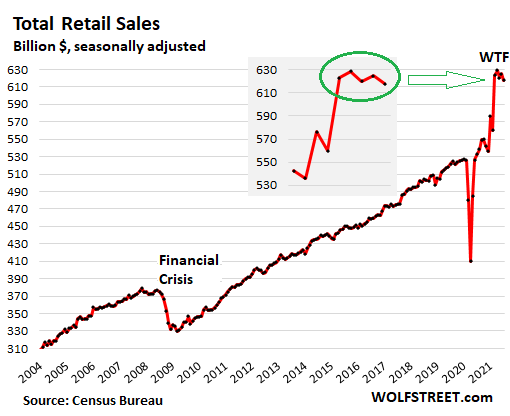
New & used auto dealers and parts stores: Sales dropped 3.9% in July from June despite rampant price increases, to $127 billion (seasonally adjusted), the third month in a row of declines from the stimulus-powered spike in March and April. Year-over-year, CPI inflation for new vehicles surged 6.4% and for used vehicles 42% (forty-two %), even as new vehicle sales volume plunged in July.
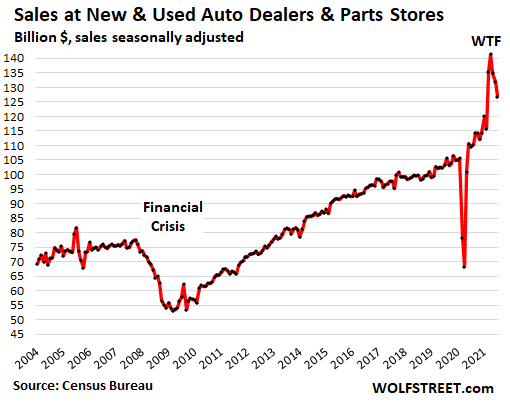
Auto dealers and parts stores are the dominant retail segment, accounting for over 20% of total retail sales (black line in the chart below). Nonstore retailers, which is mostly ecommerce, have jumped into second place (red line), followed by Grocery and beverage stores (green line), restaurants and bars (purple line), general merchandise stores (Walmart, etc.), building material and garden supply stores (Home Depot, etc.), followed by the rest:
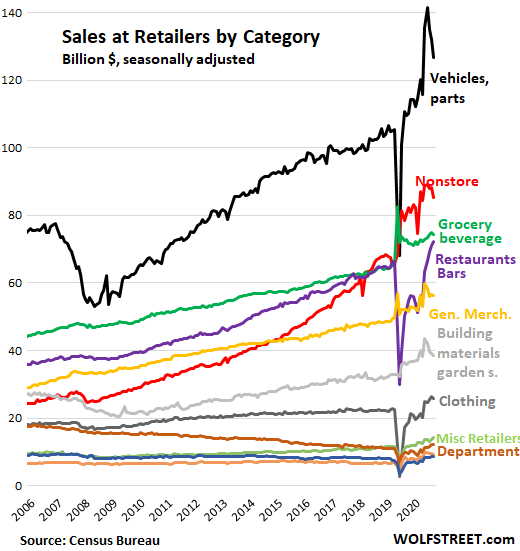
Ecommerce and other “nonstore retailers”: Sales fell 3.1% in July from June, to $85 billion, seasonally adjusted, but were up 27% from July 2019. This includes ecommerce sales by any retailer, including the online operations of brick-and-mortar retailers, plus sales by mail-order houses, street stalls, vending machines, etc.
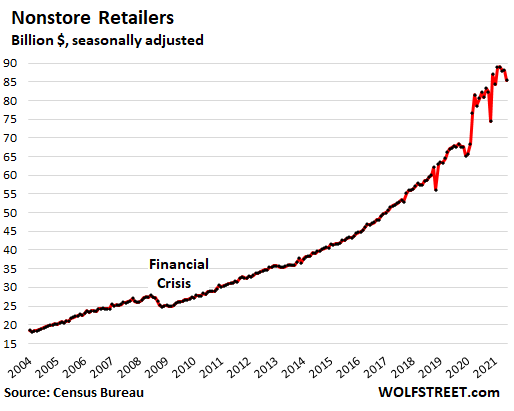
Food and Beverage Stores: sales fell 0.7% in July from June, despite surging prices – the CPI for food purchases at these stores jumped 0.7% over the same period. At $74 billion, sales were still up 15% from July 2019, driven in part by how life for many Americans has changed, including the shift to working from home, or not working at all, that moved some consumption from commercial buildings to supermarkets.
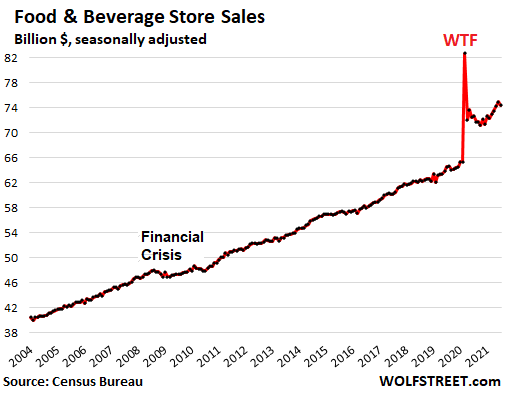
Restaurants & Bars: Sales rose 1.7% in July to $72 billion, the third monthly record in a row, and were up 12% from July 2019, amid widespread price increases and the phenomenon of “revenge spending,” where people, after all the hardship, just want to blow some money to buy satisfaction for the soul:
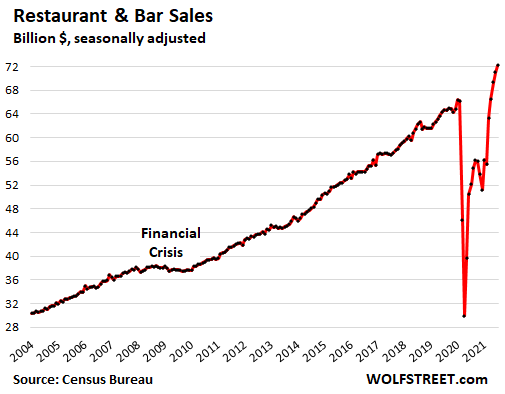
General merchandise stores: Sales were roughly flat in July, at $56 billion, and were up 16% from July 2019. The brick-and-mortar stores of Walmart, Costco, Target, etc. are in this category, but not their ecommerce sales (included in nonstore retailers):
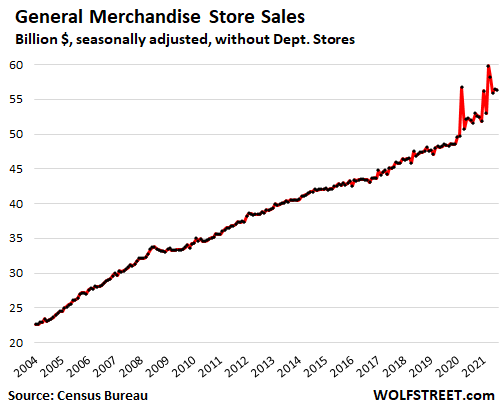
Building materials, garden supply and equipment stores: Sales fell 1.2% for the month, the fourth month in a row of declines, to $39 billion, as the passion for DIY is starting to fade – confirmed today by Home Depot’s earnings report – but were still up 22% from July 2019:
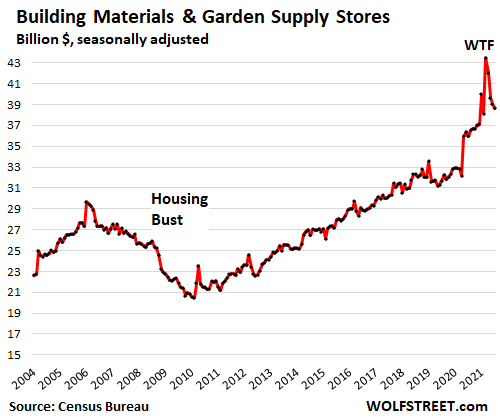
Gas stations: Sales rose 2.4% for the month and hit an all-time high of $49.5 billion, amid soaring gas prices and a large-scale shift to driving for vacations in the US, as foreign destinations are mostly too much hassle or impossible to get to. This surpassed the previous records in July 2008 ($47 billion) and February 2013 ($49 billion). In both those periods, crude oil was over $100 a barrel (WTI). Currently, WTI trades at $67 a barrel. Sales at gas stations also include sodas, junk food, beer, motor oil, and other stuff they sell:
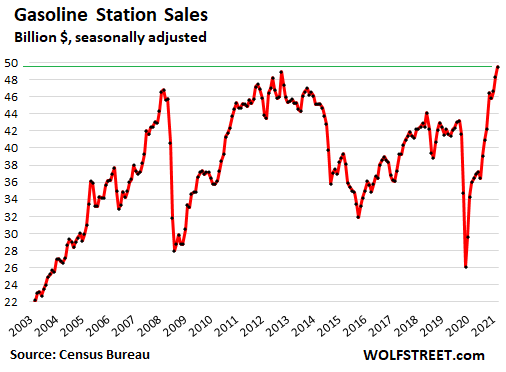
Clothing and accessory stores: Sales fell 2.6% in July, wiping out the gain in June, to $26 billion, up 15% from July 2019:
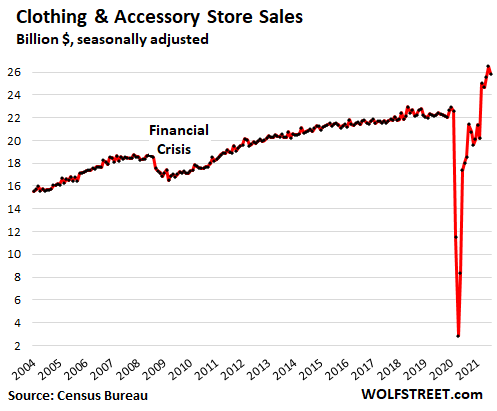
Miscellaneous store retailers, boom in legal cannabis? Sales jumped 3.5% for the month to $14 billion and are up 26% from July 2019. This is a category of specialty stores, many of them tiny, selling just one category of product. And it includes a newly legal type of store in many states: marijuana retailers:
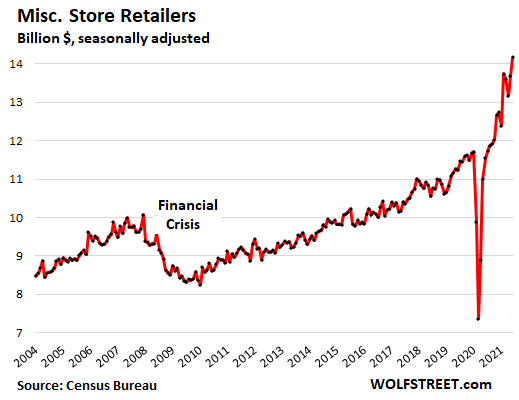
These miscellaneous store retailers make up a fun list. Here are some of them:
- Architectural supply stores
- Art supply stores
- Beer making supply stores
- Binocular stores
- Cake decorating supply stores
- Calendar shops
- Candle shops
- Cemetery memorial dealers (e.g., headstones, markers, vaults)
- Closet organizer stores
- Collectors’ items (e.g., autograph, card, coin, stamp) shops (except used rare items)
- Electronic cigarette stores
- Emergency preparedness supply stores
- Fireworks shops (i.e., permanent location)
- Flag and banner shops
- Flower shops, artificial or dried
- Home security equipment stores
- Hot tub stores
- Janitorial equipment and supplies stores
- Marijuana stores, medical or recreational
- Monument (i.e., burial marker) dealers
- Police supply stores
- Religious goods (except books) stores
- Swimming pool supply stores
- Trophy (including awards and plaques) shops
- Wine making supply stores
Furniture and home furnishing stores: Sales edged down 0.6% for the month, to $12 billion, but were still up 21% from July 2019:
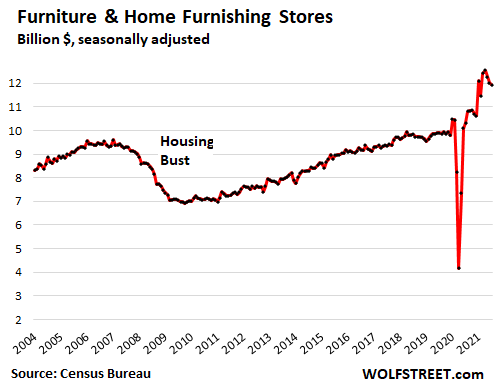
Department stores: sales edged down 0.3% for the month, to $12 billion, up 6% from July 2019. This includes sales at brick-and-mortar stores of Macy’s, Kohl’s, J.C. Penney, etc., but not their sales that were originated online (ecommerce):
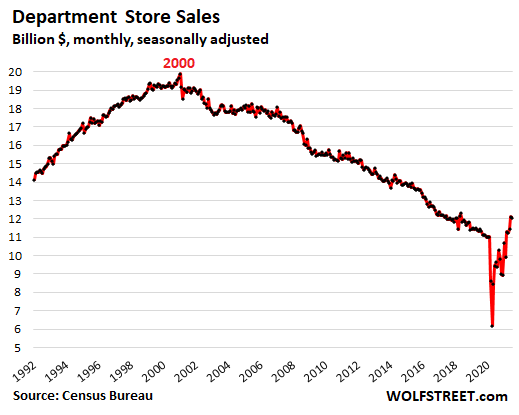
Sporting goods, hobby, book and music stores: Sales dropped 1.9% for the month, to $9 billion, but were still up 38% from July 2019:
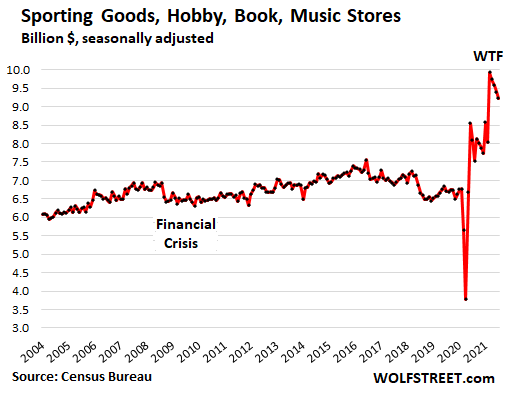
Electronics and appliance stores: Sales were flat for the month, at $8.6 billion, and were up 4.7% from July 2019. These products, a booming business in the US, started shifting to ecommerce many years ago. And these are the crumbs left for brick-and-mortar stores to fight over:
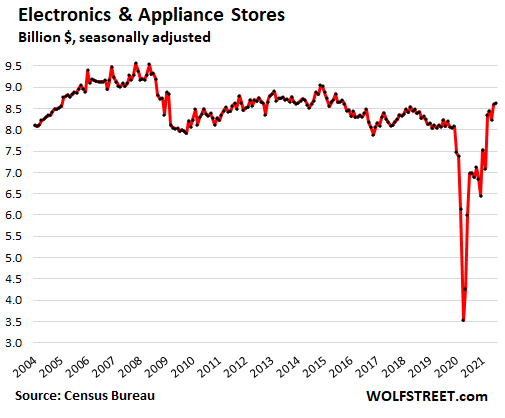
Enjoy reading WOLF STREET and want to support it? You can donate. I appreciate it immensely. Click on the mug to find out how:
![]()


The way the market closed today, for a brief second there I thought it would’ve bounce back into positive despite these not so cheery numbers.
It did go down 400pts plus during the low of the session but you guessed it, hopium and buy the dip strikes again…wonder what kind of bounce up we will see tomorrow.
With more signs this economy isn’t all rosy as the lemmings would like to cheer on and on about, how much longer are they going to exhaust the market is forward looking talking points again to support another rally? It’s getting old and tiring..
Remember how they used to laugh at the ‘Dow 36,000’ guy when the Dow hit 6,600 after peaking at 15,000? 36,000 is almost here.
More proof that timing is everything, but more stimulus is needed.
Powell’s term is ending soon. I nominate Maxine Waters, the head of the Financial Services committee that monitors the Fed, the Treasury, and the SEC, to succeed him.
Everything is fine. Just ask the Bureau of Statistics.
Kashkari is dying to be Fed chair and will do anything to get there
MMTer
I can’t imagine why anyone in their right mind would want the Fed chair in this environment!
jzfl,
One word is all that’s needed to imagine why:
“Power”
(And don’t forget the cumulative multi-million dollar speaking gigs that the Federal Reserve Chairperson gets when they leave office. Not a bad payday, eh? Ask our current Secretary of Treasury about this.)
All you needed to know was
20 trillion in new monetized debt
A Fed that promotes inflation
QE for ever
A Fed that buys MBSs 2% below the inflation rate
There’s 4 trillion on the side lines they want it
@Phoneix_Ikki
With hopium and DIP buyer will keep on doing blindly what they are trained ‘pavlov’ acts with a lot of faith in Fed’s put. I think the sentiment is slowly changing. Mkts will be volatile – up, down, up, dow, down x repeat – the classic secular BEAR! If it bounces tomorrow, my puts are ready to get executed on jets, cruise lines++(again!)
Delta variant is affecting more children unlike the Alpha, like last year.
Just read that Yellen is delaying the annual report on social security status. It is 4 months past due and most likely is more bad news. Administration trying to sandbag until new spending bills get through Congress.
Try ignoring quarterly filings on your business and see how you get treated, but a law in DC is as squishy as a rotten banana.
This is really a thing?
“Binocular stores”
The hammer will come down when folks have to start paying rent, mortgages and student loans again.
I think these charts and others like them are what Larry Summers are looking at. Why the heck would you throw more money at the economy than the precovid run rate when you already have a government debt problem and a China problem?
Plus history tells us you just get the economy addicted to ever more ‘printing’.
This seems like the likely scenario – imagine having an extra couple thousand a month stacking up in your bank account for months on end. It might be enough for people to go out and buy binoculars.
What happens when those bills aren’t forgiven – and back-rent is collected?
A lot of second-hand binoculars for sale.
With all the people staying home perhaps some are imitating Jimmy Stewart in Rear Window?
Boom. This!
Realtors “buy now, prices won’t drop, blah blah blah, high lending standards, supply!”
Oh yah? everyone is rich? Then Why TF are a million people+ not paying rent/mortgages?
Inflation will keep raging! Not once the Gov stops sending checks/unemployment bennies+ extra, make people pay student loans.
The big PPP loan money is already firmly in the hands of the 1%, but it will trickle down. /s
Yes… I assume if you extend the meaning to telescopes. At the NorthPoint Shopping Center a few blocks away from where we live, there used to be a telescope store. All it sold were telescopes and binoculars and maybe the occasional monocular. It closed some years ago and was replaced by an empty space for a long time until they finally found a Subway franchise that moved in, and which is now closed as well. Tough going.
Miscellaneous store sales surge! Great. Lots of ex corporate types opening stores that reflect their interests?
Maybe we’re having a slow return to mom and pop specialty stores and away from big box mall Chinese junk importers? Excellent!
One thing that you can do to help your fellow Americans in the service and retail sector; pay cash for everything.
Yeah, that’s helping them “cheat”, and cruelly deprives the Pentagon of money to waste on the next losing foreign war.
Darn, darn and darn. I know life is (mostly) invaluable, but the megabillions of materiel we have left behind for the “insurgents” over the last too-many decades is f’in ridiculous! How do we continue to waste so much? Oh, right, its not wasted – we made corporate profits from it.
And our grandchildren will be paying the taxes that paid for that military junk. But let’s not overlook the most important thing. Most of that money went into the pockets of the top 5%. It’s a big club and we ain’t in it.
It’s a big operation and cost to bring all that heavy stuff back to the U.S. so we could scrap it. It makes sense to just leave it there.
Yes, it makes sense to leave it there…. after you put in in a big pile and blow it to smithereens or take armor piercing bullets to the drivetrain.
Odds are, one of the armament companies are contacting the Taliban through an intermediary and buying parts and munitions as we speak.
When I was in northern Afghanistan back in the day, you could see rows and rows of old Soviet era tanks and artillery that was just left behind. And it was left, probably abruptly, to rust away.
There are winners in war: the contractors (Halliburton et al), the mercenaries, the ‘defense’ sector that builds the death machines. And dont forget that sweet resource stripping after the country is conquered
Google Eisenhower Kennedy Industrial Military Complex speech. Should be required reading in every school syllabus. Very simple. Very profitable for those on the right side of the ledger.
A very cynical part of me has been wondering if the Afganistan pull out was partially to save money. America is like an emaciated body with a bunch of vampires feeding on it. Maybe some of the bigger vampires have to be booted off to make the body last a little longer. Otherwise they all have to find a new meal.
It was a rare time politicians listened to American people who after 20 years said they were tired of sending their kids and money off to try to make it into USA light.
Plus the USA military industrial complex has increased to include the NGO complex. Heard that 50% of Afghanis were on government pay of which 80% was foreign (mostly US) money.
All made possible by the money printers, because if it was by direct taxation people would have said get out 19 years ago. All your interest income went to foreign wars.
Fantastic graphs yet again!
It’d be really interesting to compare some of these with the historic equivalents from about 50 years ago, as the 1970s inflation started to kick in.
Relevant FRED data series:
Retail Sales, SA, 1947-2001: RETAIL
Real Retail Sales, SA, 1947-2001: RSALES
Retail sales, NSA, 1946-1974: M0689BUSM144NNBR
When 1970s inflation “kicked in”
Interest rates were already at 7%
Actually the 1970s inflation started in the 1960s. CPI-U had been low for over a decade, and then when the inflation started it crossed 2.5% in 1966, then 5% in 1969.
T-Bill yields were 4.5% in 1966 and bounced between 5-7% through 1973. They didn’t cross 7% in a sustainable way until 1978, when inflation was also >7%.
The big question is whether interest rates provided protection against the inflation. Real yields (T-Bill minus CPI-U) stayed slightly positive (0-2%) only until 1973. From 1973-1981 interest rates did NOT keep up with inflation, with real yields ranging from 0 to -7.5% while averaging maybe -2%.
Interestingly, the more recent data show that real yields have been in the -0 to -3% range for nearly all of the time since 2008, with this year’s dip to -5% being a new extreme.
The era of “earning interest well above inflation” only lasted from 1981-2008 and is now long over.
Us savers can’t “just save” (bank deposits, T-bills or money-market) anymore. We have to be investors and figure out how, where & when to put our savings to work, if we want it to grow. We have to earn our returns now.
High real negative rates are going to lead to people buying gold in my opinion. Dollars are only a store of value for a year max now. If you want to store value for a decade, dollars will not do.
Back then we had a Fed that fought inflation
Now we have a Fed that promotes inflation
So where to now? The stock market is still not reflecting the economic reality and is highly over leveraged but then there is nowhere else to go. Treasury yields will stay suppressed by the Fed for a long while yet. Real estate appears to be flattening out but not yet declining.
Any asset market ( either Real Estate or Stock Market ) is totally detached from the economy. But I don’t see these going down as FED won’t taper and raise rates.
Stock market or real estate may not go up a lot for quite some time but I don’t see them declining in general.
When nearly everyone thinks assets won’t decline is when they do.
“FED won’t taper and raise rates“.
Care to place a wager on that? Guarantee taper this fall, MBS first.
Rates will take a while.
Fed will be late, but they will taper. Anyways, That’s what my crystal ball says.
They would try but with small drop in market they’d backtrack
Tapering is still conjuring cash out of thin air.
FED notes are “the world change and so must the FED” so basically they are saying they learned a lot by helicopter money exercise. Expect more. Lots more. The question was can they completely create and fabricate an economy out of thin air. Guess the answer???
Can’t nation build worth a crap. But can build an economy out of the printing press and being the buyer and seller of national debt instruments
Where to asks Anton?
Hold onto your RE but no HELOCs for toys or other investments.
NO RE PURCHASES NOW.
Stay in the stock market but take some profits and go to cash.
Wait for the inevitable bear or superbear market.
Patience. Stay calm. Patience.
Just by coincidence I spent the bulk of our clothing budget in July. Cleaned out the closet and needed to replace a few things. Here are a few of my observations.
Got good deals on clothes at my favorite stores, more than 50% off on everything I purchased for myself. Sales may be down because the discounts were good in July.
Bought my husband his favorite golf shirts, usually $89 each, on sale twice a year @ 3 for $110. Now they are $39 each, regular price, a very good price. I think WFH has affected the price of men’s clothing.
I always shop the sales first, before I buy anything, and I didn’t have to look beyond the sale items to buy everything I needed. The Nordstrom Anniversary Sale was good for me this year as well. I get a good deal there every year on something.
So much for inflation.
I haven’t seen inflation in clothing or spa services in the last year. The only expensive items were car repairs, which were extremely expensive. And also furniture, still looking for an affordable mattress, maybe will find on Labor Day.
In the last five years our food budget more than doubled. Now it seems to have stabilized, but there are items I have trouble finding.
When I was at the beach I stopped by a great thrift shop associated with a church. Nice shirts, all like new $2 each, one was Nike. New pair of Levi’s $4. New looking sheets $3. Soft sided thermos cooler $4. I just can’t bring myself to shop new anymore for anything but food.
I buy all my clothes at thrift stores. There is on non-profit near me, run by the Lupus Foundation, that has practically new shirts for $5. They have pockets which I like where you can keep your pen or pencil. They also take donations. I donate all my charity items there, so its a two way street. Screw the malls. They are dinasores.
I can buy brand new shirts on Amazon for around $5. As long as you don’t care about logos and graphics.
I both donate and buy at thrift stores. The Goodwills I go to always have new items as well. Bought some nice socks last time I was there.
I picked up a $135 pair of Nike Frees for $20.
Good Will Rocks!!!
How have department stores lasted this long? And even registering a small increase? The only way I can imagine that anyone actually choses to shop at a department store is either lack of alternatives or simply out of habit.
That being said, I actually do miss Sears. Always bought my appliances there. But nothing else.
MiTurn,
Many of them haven’t lasted this long. They were shut down long ago. The first that went bankrupt were the local family-owned stores decades ago and then the regional chains years ago. Then came the larger chains. Then came Sears. The surviving chains have closed thousands of stores over the past five years. It’s been total bloodletting.
If I could come up with a price-adjusted (prices of the goods sold at department stores, not overall prices) 20-year sales chart, it would look a lot more horrible than the chart I posted.
I can remember back to the 1950s, when towns and cities had main streets with thriving shops. Then the five-and-dimes (the F.W. Woolworths, for example, and another one whose name I can’t remember) moved in. The little shopkeepers were upset because they were being underpriced. Then the K-Marts, the Wal-Marts, the Targets, etc. moved in, staying on the outskirts and the central business districts died. Now we have Amazon threatening the big box stores. Things are always changing. However, my shopping habits have stayed the same. I try to consume as little of the Earth’s resources as possible and I’m frugal, even though I could in my old age start spending freely.
Yes, I noticed that restaurant sales were up as other fields were flat or hurting.
That “urge to get out and spend” will fade once people get used to the novelty of not having to wear masks.
My Bank just announced that all employees in the office/branch have to wear a mask regardless of vaccine status. So get used to the masks to return.
Very useful charts, Wolf – thanks. “Retail” sales is almost meaningless without category detail.
Wolf,
Just to reiterate a point you briefly touched on…increasing inflation (gvt supplied) increasingly makes current and historical gvt statistics (almost always defined in USD)…increasingly meaningless.
If units produced/consumed fall by half but prices double, most gvt stats make it look like utility is unchanged…because the gvt metrics “can only” be reported in aggregate dollars (rather than units produced/consumed).
But the underlying reality is that inflation (while gaming the stats), has actually sliced aggregate *utility* in half…because only half as many units are being consumed.
It is a very simple, obvious point…but one far too rarely focused upon…because the G tends to only publish/use metrics it can game. (See unemployment rate, GDP, etc.)
Cas, love this comment.
Back in the 1960s-1980s industrial era, you could easily find unit production stats all over, including tables for each nation and state in encyclopedias.
For some commodities (e.g. oil), unit production isn’t the whole game, since efficiency can leverage a lot of utility from a single unit of material. Similarly for tech products. But for others (e.g. wheat, shoes, lumber, tires), the unit of production is basically the unit of utility.
I would love to see energetic young statisticians finding good ways to track unit production again, although there are many incentives to hide the true levels now.
=energetic young statisticians finding good ways to track unit production again=
Dem damn energetic young statisticians migrated to greener pastures in private sector.They still track unit cost production for the US and other countries,among other things…
“Statistical Abstract of the United States” was privatized in 2011 and is now selling for $220 on Amazon,courtesy of ProQuest.
Last price in 2010 was $40 per paper book or free .pdf file downloadable from US Census Bureau website.Considering the size & page number of that book $40 was just a printing costs.
1878-2011 R.I.P.
cas127,
Auto sales are reported in units on this site, for example. They account for over 20% of total retail sales. But they’re reported on different days because the data is released very early in the month. So you have to read it then, and not complain about the lack thereof now. I also linked those articles in the article above. All you have to do is click on it. So here they are again.
New vehicles unit sales for July:
https://wolfstreet.com/2021/08/04/new-vehicle-sales-july-took-huge-hit-in-july-from-semiconductor-shortage-record-low-inventories/
Used vehicle unit sales for July:
https://wolfstreet.com/2021/08/06/used-vehicle-madness-unwinds-a-teeny-weenie-bit-for-2nd-month-idiotic-price-spike-of-pickups-unwinds-most-but-still-up-25-year-over-year/
I’d expect to see the manufacturing sector reporting major profit misses with the PPI so high, higher wages, and less units sold. Eventually that could hit services more broadly. Advertising might lose priority if there is an actual contraction in consumer spending.
Taking a long term perspective, the worst case scenario is consumer price inflation is transitory and the Fed continues with its ultra easy monetary policy. Wealth inequality will get even worse. Many people will be priced out of the housing market. Retirees will struggle to fund their retirement. Fixed interest will all but disappear as an asset class. Pension funds will have to take on more risk to fund their liabilities. None of this is good but the Fed will claim it saved the world.
Many people are already priced out of the housing market. The latest thing I’m hearing is sellers who only want cash offers. They know the house won’t appraise.
Also hear landlords will get tough on renters in the future. Wanting more rent and higher income tenants with excellent credit. What planet are those people on. Nobody will qualify for their overpriced crappy houses.
Petunia
If wage increases continue (and it appears they will), then rent increases will follow. I am guessing the govt eviction moratorium which then created the govt rent backstop programs, will become permanent. Rental housing could soon become completely subsidized. If so, then rental real estate might have some cash flow insurance in the future and thus worth buying ??
What wage increases? Most older workers on unemployment have given up and retired. All the hospitality workers are complaining they only get 8 hours a week and not even on the same day every week. The employers want the workers to starve. The homeless population is growing everywhere.
Where we agree is that rental housing is going to become completely subsidized. And that means rent control and regulation.
I hear that legislation has been proposed in Germany to make all private rentals govt housing. Keep an eye on that because it’s probably the tip of the spear.
There is no meaningful wage increase happening. But the govt and media would propagate this lie as part of their propaganda.
Not much of a pullback yet, except with autos, but that was somewhat predictable.
Thanks for the killer graphs Wolf !!
Beardawg,
I’m amazed actually at how well overall retail sales have held up — with some things dropping and others rising — after the WTF spike earlier this year. That spike looked like it would have to implode, but it didn’t. It just got a few little dimples so far. Maybe when the extra unemployment benefits expire, and rents are due again, and mortgage payments need to be made again, and student loan payments need to be made again… oh well, forget it :-]
Big picture is Feds borrowed all of private savings last year and handed it out per Keynes theory of spending in a depression. Most people just spent it as can be seen, as more than half of Americans don’t believe in savings anyway.
They only “borrowed” it if they ever actually remove that liquidity from the economy; that is, unwind QE. If they never do, then they stole the private savings, not borrowed them.
Also, while I’m not a Keynesian, Keynesian’s theory wasn’t premised on the “stimulus” used to buy durable goods made overseas.
Low interest rate, high inflation, sawing is losing money. Plan for cash flow til the end and carry as much debt as possible to the grave.
The one with the most bank representatives crying in the funeral wins.?
One thing hurting retail sales is the new mask requirements. I went and got vaccinated so I didn’t have to wear those god awful masks which are very annoying, ugly and unhealthy, and which don’t work very well (two close friends of mine who were wearing masks regularly and not vaccinated are now 6 feet under). Now you are greeted at the entrance of every retail store with a nasty sign ” NO ADMITTANCE WITHOUT FACE COVERING, VACCINATED OR NOT”
Doesn’t that put you in mood to shop until you drop???? Hell no. I only spend on bare necessities. I’m sure a lot of other people are doing the same. Hence the decline in retail sales.
I don’t mind masks. The thing that gets me is the smoke from the wildfires to where you shouldn’t and don’t want to go outside unless you wish to shorten your life expectancy. I’m an outdoorsy person, I like to exercise and breathe deeply, and now the dense awful smoke has come back, right on schedule, like last year when the smoke moved in on Aug 23.
Wolf
Yep, and you sent the smoke here to the east coast via the Jet Stream. Noticed the foul air, along with all these trucks here doing roadwork that haven’t been tuned up in 20 years. DC Swamp doesn’t require emissions testing. The air quality is awful.
I told someone the other day “I can’t breath” . I think we’ve heard that phrase before.
Amazon pulled their Prime Day forward and still missed earnings. Walmart however posted very good numbers and raised their forecast for the year. Their online division however grew at a slower pace. Didn’t know that people were yearning to get back to Walmarts. Also one of them is going to be wrong here. Either retail (both online/offline) will do really well or they’ll just miss expectations for the rest of the year. Maybe Walmart is counting on more stimulus.
Amazon posted double digit earnings growth Q2. The S&P 500 posted double digit earnings growth Q2. Waiting for housing prices to go up. They won’t go down forever. Credit cards paid down.
Of course they did. Their customers were given trillions of free money to spend. How could you not have amazing earnings growth in that environment?
We have started doing our grocery shopping online and picking the order up at Walmart the next day. It’s the best of both worlds when you live, as we do, outside the delivery zone: we get Walmart prices, but without having to go into the store and deal with (ugh) people.
Everything that has transpired since 1961 was accurately predicted by the smartest guys in the room.
See: “Should Commercial Banks Accept Savings Deposits?” Conference on Savings and Residential Financing 1961 Proceedings, United States Savings and loan league, Chicago, 1961, 42, 43.
I just ran into some inflation at my local grocery store, Giant. Produce has started going up slightly for the 1st time in a year. The other issue is supply chain problems. They are running out of essential items. Had to go to the competitor Safeway to get the rest of the items. Safeway is way overpriced. They are 10% to 15% higher. Whole Foods is even higher. Had no choice but to shell out the money to get what I needed. Was shocked when I got to the checkout and found no workers. They are so cheap that they won’t pay for a single worker. They wanted everyone to go to the self service checkout. Customers started to walk out. I almost did the same, but finally someone showed up at the checkout counter. Safeway will be the next company to go bankrupt. Good. I can’t stand shopping there.
Current push for $15 or $20 and Covid is going to eliminate a lot of jobs with technology. Grocery store can probably borrow at around 3% to put in a self checkout. Even if $100,000 that’s $3000 per year interest cost.
I make the joke once we are the cashier, we will be stocking shelves next.
Old School,
Our local Safeway has been using self-checkout for a decade. It’s now on its 2nd generation of machines. Works great if you have just a few items and no alcohol. If you’ve got 100 items in your cart, including lots of produce as we usually do, you’re going to be laboring on it for a while.
They might have one human cashier open, plus 10 self-checkouts, plus one person supervising all 10 self-checkouts. Makes total sense — switching labor and expenses from the store to the customer. Self-service started that many decades ago. And this is just a natural extension of self-service.
I prefer it this way. At most stores, all of the self checkouts share the same line, so you don’t get stuck behind someone who is very slow for whatever reason, as happens with regular checkout lines.
Around here in more deserted places there are small grocery stores that are open all day all night, but not staffed all the time. Debet/credit card work as key to door to enter store. Self check out and the door let you out when you have paid. There is also a sign on the door, cameras in action…
” switching labor and expenses from the store to the customer.”
I could not disagree more
I think they have forgot one thing about this automation. It may work for them but maybe some customers don;t like this new paradym.
The famous quarterback of the Minn Vikings, Fran Tarkenton who went to 4 super bowls once said in his book on small business success,
” The key to success is keeping your customers that you have and then working your marketing to find new customers”.
This total Bull s$it about the advantage of self service kiosks, switching the labor to the customer, allowing labor unions to run the whole grocery operations, fund raising at the door, do nothing to serve the customer who needs to get their essential groceries and get the hell out of there. Right now they are having massive supply chain problems and the prices are outrageous for quality food. If they want to keep their customers I think they focus on this instead of this other bull s$it. END OF STORY
I got used to automated check-outs years ago. I prefer them to people. They’re quicker. Normally you can walk right up to them. However, my wife and I shop at Trader Joe’s, Aldi’s, and Lidl, which still have cashiers. There’s also an Asian-oriented supermarket with low fruit and vegetable prices. The regular chain supermarkets are higher priced.
Recent economic indicators hit at slowing growth and inflation. If this pattern continues, housing will substantially outperform stocks, just like they did in the late 70s.
We are still in the early innings of a historical pandemic economy. We all know or at least should know of the long list of manipulations that have occurred, most of which are still in place. TPTB are not done either. These people are flying a plane through a 100 year storm. They are not going to glide it in for soft landing.
Petunia,
We bought a very nice memory foam mattress from Costco, plus one that was about 6 inches too thick which required me to build a new bed frame. Both mattresses are firm and comfortable. It was quite a bit cheaper than our local bandit furniture stores.
I want firm support and inner springs. The prices are simply ridiculous. I refuse to spend $2K+ for one mattress. Staring inflation in the face and not backing down.
did you try IKEA?
We had guy in town that had a small warehouse that he paid about $400 monthly rent for. He was a one man show and sold mattresses about half price to anyone else. He bought some out of a factory in Texas and some out of a factory in Virginia.
Must be somebody with a factory close by. If there is a factory, there is a way to get them cheap with a minor cosmetic flaw.
Thanks, we are mattress shopping too. Costco has some very good prices.
I was told there was a foam shortage affecting furniture. Evidently, there are only 4 plants that make the chemicals used to make foam. 3 of the plants are in Texas and they lost power back in February and are still unable to resume full production.
Everything is running in Texas, including the chemical plants.
A few years ago I was in Sears to buy a replacement mattress and box springs. One of them was on sale. The salesman at the time told me the mattress was a piece of s$it. Can you imagine this?? Now I know why Sears is going bankrupt.
I would guess that everyone who has eyes that can see are stocking up for possible hard times. Gotta eat, gotta imbibe, gotta have somewhat durable threads, AND a nourished horse to get at it all.. Considering our collective ongoing national denouement, I say that Winter seems to indeed be Coming…. and it seems as though the FEDead will never relent .. in the Realm’s ongoing destruction!
Misc stores sales surge (aka “legal mj”) may also reflect the surging cost of chlorine tabs for pools at those swimming pool supply stores. One year ago that 40 lb. bucket was ~$75 and this week I grabbed one of the last available 35 lb. buckets in Austin, TX for $150. Most stores in the area are now completely sold out for now.
Use bleach for chlorine and never turn back. Search for thr website trouble free pool.
Reading comments about retail, I am struck by how fetishized commodities have become, both the bizarre number of offerings of detergent or cookies, for example, to the way in which they are peddled, like low-brow whoredom of the stuff of life. You know, the necessities that should be fairly neutral, not a lifestyle choice. And as consumers we claw for the 47 cents in savings at Walmart and now Amazon, while the physical landscape around us disintegrates, that is, we have few community spaces left, maybe school, while “in” the office at Zoomville, only one disembodied head gets to talk at a time. And in reading the comments from those with far more economics knowledge than me, the markets are equally fetishized. Like we have become a world of humans with nothing better to do than gnaw ourselves from the inside out over money—at least those with economic privilege. It’s all kind of nightmarish and yet also the logical conclusion from seemingly benign beginnings.
The American style of capitalism ended up with an excess of products on the shelf and limited dollars to purchase them with so selection was made on personal affordability. Worked pretty well for a lot of years.
Other extreme was Soviet style central planning resulted in people having money in their pocket and long lines at the store to buy limited product offerings.
Fetishized is good way to describe the spending in both the consumer and investment markets. Got to have that Rollie, the logo tee shirt, expensive sneakers, and designer backpack. To go with the EV stock, i stock, carbon credits, and crypto.
It’s a sad truth that a large percentage of our purchases are because of what others will think of us. Marketers know this and really work us over emotionally.
I am at happy stage of life where people kind of expect you to be an old guy with lowered standards.
New York Times is giving you a run for your money with their pretty inflation charts, Wolf, scrubbed of all WTF-ness
LM,
The New York Times, which is an over-indebted company, has always been one of the biggest proponents of higher inflation because higher inflation allows the NYT to raise its subscription fees and thereby its revenues, and thereby allows it to service its heavy debt load more easily and pump up its shares.
The NYT has hounded the Fed for years, including during post-FOMC meeting press conferences, about not creating enough inflation.
Now it tells its readers, literally, “Don’t worry about inflation….”
The NYT economic coverage is self-serving and a crime against people who earn their living from labor. If you get your economic coverage from the NYT, you’re being deceived.
If readers don’t mind jumping through a few hoops, they may be able to read the NY Times online for free. My county library system worked out a deal with the paper to let its library card holders sign in for a free daily subscription. Check with your local library.
NYT reporting, including its economic coverage, IS biased. It also refuses to publish most right of center comments.
I happen to buy corn tortillas regularly as I am allergic to gluten and gluten free bread is quite expensive. Trader Joe’s recently raised the price of their corn tortillas by 30%. Fortunately, I can absorb the increase as my dividend income has gone up in the past year.
People who live in Pacific Gas and Electric’s service area in Northern California should be prepared for a rate increase of up to 18% in the coming months to pay for the 2018 wild fires.
archive.is can get you around some of those paywalls.
Your tax money is going (Via library) to the NYT. Your local government is subscribing with your tax dollars.
Every electric utility has it’s issues. On most of the east coast its trees falling down on power lines during a wind or snow/ice storm. If you are out in the boonies it can be up to a week to get power back on in a big storm as you are last on the list.
No, I get my heady economic knowledge here! I like the mini crossword over at The NY Times.
Wolf: Been reading about some companies wanting to reduce the pay of employees who continue to work remotely vs. coming back to the office. In the meantime, these companies are using the employees electricity, internet connection and their real estate (their homes) at no cost. Said companies are also reaping the benefit of decreasing the amount of office space they lease, another big saving. Seems to me that the companies are being overly greedy here. Would love to see you write an article about this. Thanks.
I’ve been discussing this for almost a year. That’s why corporate cost cutters LOVE working from home, and that’s why there is so much momentum behind it. These discussions take place here under various topics, including working from home and commercial real estate (“footprint reduction”). You can save a ton of money by getting rid of some corporate office buildings and everything that comes with it, including the gourmet restaurant.
Here are a couple more recent ones:
https://wolfstreet.com/2021/05/05/now-even-google-caves-under-demand-for-permanent-work-from-home-another-blow-to-bay-area-office-market/
https://wolfstreet.com/2021/05/04/the-dynamics-behind-the-ugly-amount-of-empty-office-space/
https://wolfstreet.com/2021/01/13/citing-permanent-shift-to-work-from-home-dropbox-cuts-11-of-its-workforce/
I keep hearing people making the argument about increased electricity and use of home, but I’ve never once heard anyone who LIKES working remotely complain about this.
I haven’t seen any companies make working remote mandatory. If you want to go in and use the company’s electricity instead of your own, go right ahead.
My ex-employer (who will remain anonymous) has scheduled days you are only allowed to go into the office. The other days (at this point, 3) are WFH. It’s a rotating schedule for the peons and varies by department. This is the result of the removal of work stations in order to provide adequate “social distancing” and now can’t accommodate 100% occupancy of those remaining employees (oh… sorry… “associates”) who didn’t take the VRO, VSP, or outright axing (witch hunts). Some spaces were consolidated (moving an off site subsidiary to the mother ship) and letting rented space go in a flurry of cost cutting.
For the most part, the impact of WFH should be minimal (unless you take a pay chop). The A/C is usually running (or heat). The lights aren’t needed during the day. Maybe a little additional TP or water consumption, but those expenses are more than made up by not buying Starbux, lunch, snacks, and the cost of makeup (for the ladies), dry cleaning, laundry, commuting costs, and the like.
You’re right, I should have clarified that once all goes back to normal.
Everyone I know who likes working from home is not going to be deterred by an extra $10/month in electricity and TP.
Wolf, I like to read the comment section of your posts on my iPad, but can’t seem to get through any of them without your web page crashing 3, 4, 5, or even more times. I wish I knew whether the problem lies with my iPad or your web page.
Confused.
also, when typing .. if a pop up add arrives, the typing cursor disappears…
an annoyance, no big.
historicus,
My site doesn’t serve popups. They’re being served by something (malware) in the cache of your browser. The solution is to delete the browsing history in your browser. This takes a few seconds. And it usually takes care of a lot of problems on your machine. You should do this daily for all kinds of reasons.
Confused
I had the same problem with some of my older PC’s (Pre 2016) running Windows 7 operating system. Wolf’s Web site would run slow and hang up. When I upgraded to newer Win10 machines with optical disk technology the problem went away and the site ran fine. I don;t use these older machines anymore to visit Wolf’s Web site.
Delete the browsing history in your browser. This takes a few seconds. And it usually takes care of a lot of problems on your machine. You should do this daily for all kinds of reasons. Best to set up your browser to where it does that automatically when you close it.
I forget to add that the machines in question ran pretty poorly on other Internet applications including WEBMAIL. So it wasn’t just Wolf’s Web Site. I’ve put these machines in mothballs. Not worth having or screwing around with. The new machines have much faster hard disk optical technology, faster Intel chips, and memory cache. My local micro center technician said these older Win 7 machines were not even worth upgrading to Win 10. I have 3 machines running Win 10 and they are all working fine on Wolf’s Website and other Internet applications including some high powered Real Estate Appraisal software tools. .
Now that I’ve bought 2 used cars and a truck for no reason at 30% above blue book, I will kill the COVID blues my driving around aimlessly.
Enjoy that $5 gas too…
Weird…..but all commodities appear to be rising a lot except oil. Sure is rose from a big drop but if you go back 5 or 6 years we are lower but land, housing, food and almost everything else is up in price. I car owner are lucky oil has not been going up the past 5 years.